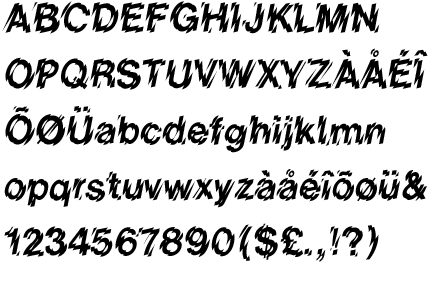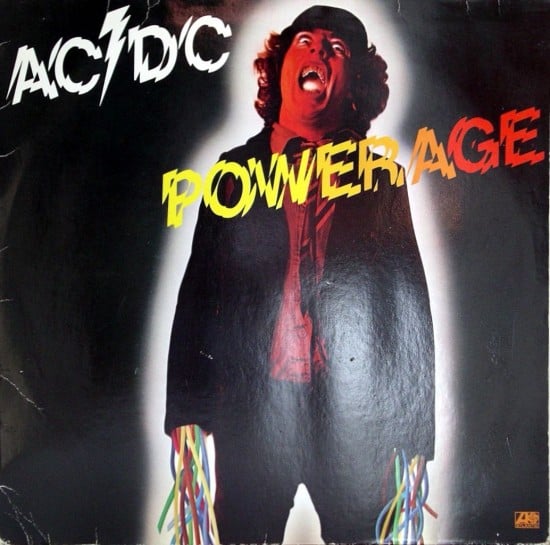Kern Your Enthusiasm (21)
By:
August 21, 2014

One of 25 installments in a series of posts analyzing and celebrating a few of our favorite (and least favorite) typefaces.
SHATTER | VIC CARLESS | 1973
Shatter is a typeface designed by British commercial illustrator and designer Vic Carless in 1973: the year that the optimism of the Sixties died and was replaced by the darker, less optimistic mood of the Seventies.
Carless was a typical post-war Brit: sensible haircut, sensible shoes, always wearing a tie, probably working on his illustrations with a pipe clamped between his teeth. By the end of the Sixties he’d produced an impressive portfolio of paintings depicting affordable cars for the fleetingly buoyant British automotive industry, and many model-airplane box illustrations. His illustration style epitomises the vernacular of conservative post-war British marketing: muted, modest, conformist, idealistic.
So what happened in ’73? Did Carless start smoking something besides pipe tobacco? How did a man who had previously been the source of so many scenes of wholesome living suddenly break character and invent a cut-and-shut typeface that stuck its fingers up to clarity and order… in a manner that predated British punk by several years?
Shatter is not inherently punk in style, but its discordant nature — born from the subversion of (then) contemporary reprographic process — is undeniably punk in spirit. Shatter’s glitch-like mechanical aggression distinguishes it from its closest predecessor: B-Movie lettering, which is distinctly hand-painted and wilfully theatrical. Shatter differs too from psychedelic lettering, which is all about organic hyper-harmony and sensuous fluidity. Shatter came neither from the hand nor from transcendental sensuality but from cold, machine-induced paranoia. It attacked the Establishment’s preferred information typography style with a sharp edge and recomposed it in a jarring manner that still makes your eyes skitter and your brain tick trying to recompose it. Shatter literally sliced up Swiss modernist authority, and created an anti-Establishment statement from the shards.
I learned early on that Shatter’s visual stutter makes it very difficult to space optically. Too close and it crashes and fights with itself; too spaced and it loses the ominous nature of a tight-knit, energised mob. It requires an extreme economy of words to be at its best, and it needs to show a brutal disregard for the elements around it. For this reason there are few examples of Shatter being used effectively. The best examples are single, potent words placed awkwardly, as though invading the graphic composition — as in the artwork for AC/DC’s Powerage album, where the title appears off-kilter, off-centre, and in every respect jarring with a relatively restrained artwork for the hard rock genre. Shatter is at its best when it appears to be deployed by people who really don’t care about the rules.
The basic energy of radical ideas is best expressed via a visual language system that knocks people from their comfort zones, presenting something so disconcertingly different that a perception shift occurs in the viewer. By cutting up the Establishment, Shatter brutally assaulted accepted norms, triggering a realisation that order and civility are participatory illusions of suppression and control. Shatter gave the designers of the Seventies permission to sample and subvert the Establishment.

2014: KERN YOUR ENTHUSIASM (typefaces): Matthew Battles on ALDINE ITALIC | Adam McGovern on DATA 70 | Sherri Wasserman on TORONTO SUBWAY | Sarah Werner on JOHNSTON’S “HAMLET” | Douglas Wolk on TODD KLONE | Mark Kingwell on GILL SANS | Joe Alterio on AKZIDENZ-GROTESK | Suzanne Fischer on CALIFORNIA BRAILLE | Gary Panter on SHE’S NOT THERE | Deb Chachra on FAUX DEVANAGARI | Peggy Nelson on FUTURA | Tom Nealon on JENSON’S ROMAN | Rob Walker on SAVANNAH SIGN | Tony Leone on TRADE GOTHIC BOLD CONDENSED NO. 20 | Chika Azuma on KUMON WORKSHEET | Chris Spurgeon on ELECTRONIC DISPLAY | Amanda French on DIPLOMA REGULAR | Steve Price on SCREAM QUEEN | Alissa Walker on CHICAGO | Helene Silverman on CHINESE SHIPPING BOX | Tim Spencer on SHATTER | Jessamyn West on COMIC SANS | Whitney Trettien on WILKINS’S REAL CHARACTER | Cintra Wilson on HERMÈS vs. HOTDOG | Jacob Covey on GOTHAM.
2013: HERC YOUR ENTHUSIASM (old-school hip hop tracks): Luc Sante on “Spoonin’ Rap” | Dallas Penn on “Rapper’s Delight” | Werner Von Wallenrod on “Rappin’ Blow” | DJ Frane on “The Incredible Fulk” | Paul Devlin on “The Adventures of Super Rhyme” | Phil Dyess-Nugent on “That’s the Joint” | Adam McGovern on “Freedom” | David Abrams on “Rapture” | Andrew Hultkrans on “The New Rap Language” | Tim Carmody on “Jazzy Sensation (Bronx Version)” | Drew Huge on “Can I Get a Soul Clap” | Oliver Wang on “The Adventures of Grandmaster Flash on the Wheels of Steel” | Douglas Wolk on “Making Cash Money” | Adrienne Crew on “The Message” | Dart Adams on “Pak Jam” | Alex Belth on “Buffalo Gals” | Joshua Glenn on “Ya Mama” | Phil Freeman on “No Sell Out” | Nate Patrin on “Death Mix Live, Pt. 2” | Brian Berger on “White Lines (Don’t Do It)” | Cosmo Baker on “Here We Go (Live at the Funhouse)” | Colleen Werthmann on “Rockit” | Roy Christopher on “The Coldest Rap” | Dan Reines on “The Dream Team is in the House” | Franklin Bruno on The Lockers.
2012: KIRK YOUR ENTHUSIASM (Captain Kirk scenes): Dafna Pleban: Justice or vengeance? | Mark Kingwell : Kirk teaches his drill thrall to kiss | Nick Abadzis: “KHAAAAAN!” | Stephen Burt: “No kill I” | Greg Rowland: Kirk browbeats NOMAD | Zack Handlen: Kirk’s eulogy for Spock| Peggy Nelson: The joke is on Kirk | Kevin Church: Kirk vs. Decker | Enrique Ramirez: Good Kirk vs. Evil Kirk | Adam McGovern: Captain Camelot | Flourish Klink: Koon-ut-kal-if-fee | David Smay: Federation exceptionalism | Amanda LaPergola: Wizard fight | Steve Schneider: A million things you can’t have | Joshua Glenn: Debating in a vacuum | Kelly Jean Fitzsimmons: Klingon diplomacy | Trav S.D.: “We… the PEOPLE” | Matthew Battles: Brinksmanship on the brink | Annie Nocenti: Captain Smirk | Ian W. Hill: Sisko meets Kirk | Gabby Nicasio: Noninterference policy | Peter Bebergal: Kirk’s countdown | Matt Glaser: Kirk’s ghost | Joe Alterio: Watching Kirk vs. Gorn | Annalee Newitz: How Spock wins
2011: KIRB YOUR ENTHUSIASM (Jack Kirby panels): Douglas Rushkoff on THE ETERNALS | John Hilgart on BLACK MAGIC | Gary Panter on DEMON | Dan Nadel on OMAC | Deb Chachra on CAPTAIN AMERICA | Mark Frauenfelder on KAMANDI | Jason Grote on MACHINE MAN | Ben Greenman on SANDMAN | Annie Nocenti on THE X-MEN | Greg Rowland on THE FANTASTIC FOUR | Joshua Glenn on TALES TO ASTONISH | Lynn Peril on YOUNG LOVE | Jim Shepard on STRANGE TALES | David Smay on MISTER MIRACLE | Joe Alterio on BLACK PANTHER | Sean Howe on THOR | Mark Newgarden on JIMMY OLSEN | Dean Haspiel on DEVIL DINOSAUR | Matthew Specktor on THE AVENGERS | Terese Svoboda on TALES OF SUSPENSE | Matthew Wells on THE NEW GODS | Toni Schlesinger on REAL CLUE | Josh Kramer on THE FOREVER PEOPLE | Glen David Gold on JOURNEY INTO MYSTERY | Douglas Wolk on 2001: A SPACE ODYSSEY | MORE EXEGETICAL COMMENTARIES: Joshua Glenn on Kirby’s Radium Age Sci-Fi Influences | Chris Lanier on Kirby vs. Kubrick | Scott Edelman recalls when the FF walked among us | Adam McGovern is haunted by a panel from THE NEW GODS | Matt Seneca studies the sensuality of Kirby’s women | Btoom! Rob Steibel settles the Jack Kirby vs. Stan Lee question | Galactus Lives! Rob Steibel analyzes a single Kirby panel in six posts | Danny Fingeroth figgers out The Thing | Adam McGovern on four decades (so far) of Kirby’s “Fourth World” mythos | Jack Kirby: Anti-Fascist Pipe Smoker
